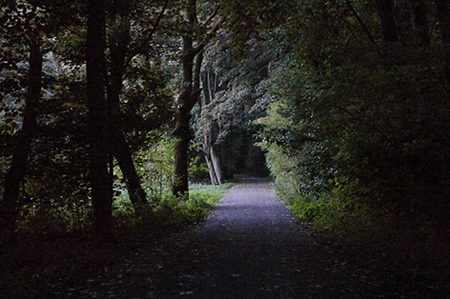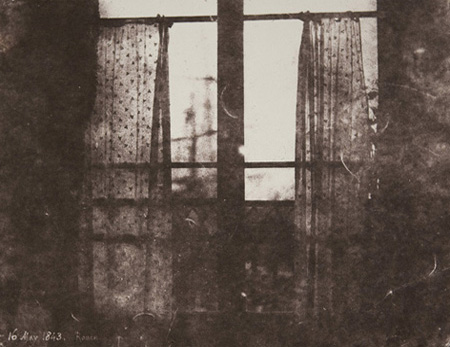User:Nicole Hametner/Graduate Research Seminar 2013-TM4.01
Project Proposal Outline - Oscillating Shadows
Introduction
I will record with a videocamera nightshots and observe how the low light zones in the image can be perceived in a multiscreen installation. The impact on the audience is central and lead the focus on the core of the image itself, through the temporal moving noise in the underexposure to the revealed object lying behind. Filmed in a fixed frame, there are urban constructions followed by views of the harbour up to a vast scene of the dark sea. The scale of each screen monumentalize the picture and evokes the idea of standing in front of a full size landscape painting. (maybe simultaniously or in a sequence, depending on the technical dispositiv of the installation)
(notes about installation: The screen hanged in the middle of the room varies between transparent window to the exhibition space and opaque surface with view on the filmed exterior scene. Its semitransparency resumes the treshold that is inherent to the underexposed videographic image itself, there the underexposure can be seen as a barrier, that opens space for imagination. Hence the observer finds itself at a transitory passage, by his glance simultaniously here and there, he shifts between the visible/outside and the invisible/inner world.)
The research I started in the second trimester is definitely what I want to deepen in the last year of my master studies. For that I will investigate technical aspects of the digital moving image during the shooting, the postproduction, the installation of the final projection as well as look at the technical construction of the video image. The self-referential language allows asking abstract questions about the dematerialization during the analog digital conversion and the loss of indexicality, what leads to a philosophical approach to the image and the notion of time. Besides that I will reflect about the form of the video installation, the role of the observer and read some theory of cinema.
In the final video installation the spectator finds itself in a delineated space surrounded by large projection screens. The perception lies in the center of my investigation and is challenged by an initially slight disorientation, comparable to a situation at night in a forest where the eye has to adapt to the low light. Filmed night shots appear on the screens, one with a view of large buildings, another one with a scene of the harbour and one with a view of the seaside. Though instead of having the blinding lights of the city and the industry in the center, the dominant part will be the dark zones in the picture. Because of the slight underexposure of the video there will be temporal moving noise, flickering of pixels, which provokes a vibration in the shadows. The aim is a composition of different low light areas, a result of more or less abstract images of an urban, industrial and natural landscape. (In addition to these three landscapes there will be projections of filmed portraits, either timed in direct reaction to the night shots or screened simultaneously in a rather loose and open rhythm to each other. For this second part I create a sequence of photographic portraits of women recorded with an additional counter zoom. Concretely the photo camera moves backwards while zooming in or the other way around. Afterwards the looped time sequence presents one image after the other with an interpolation between each one to ensure the illusion of a continuous movement. I use this effect with a black background to focus only on the alteration on the faces. The modification of the perspective provokes an illusive movement, barely recognizable.)
My interest lies in a confrontation of photography and video, from stillness towards moving image, shifting from analog to digital. I want to focus on their media specificity, by which I mean their mechanism, their materiality, how time behaves and where the question about the origin of the image leads. These reflections allow me to articulate thoughts about absence/ presence and disappearance, night/ perception and psychoanalysis and generally the border of the visible.
The crucial unique instant while triggering the photograph turned into duration while using long time exposure, what I used a lot in my previous works. Now through thinking about the construction of the electronic moving image the factor of time again plays an important role and emerges the idea that the image as such is never present as a whole. This intriguing insight links to the role of the observer, its perception and the question where the actual image is created and what does it mean if it never exists all at once? These reflections about the conception of the moving image increase my interest for the origin of the image, which can be understood as foundation that drives me in my research, with the ambition to achieve a good balance between theory and practice to strengthen the completion between concept and production > thesis.
Relation to previous practice
Methodologies: Several interests and points of research over the years have built a background that serves as constant reference and flows into the concrete creation of a specific work. It can be seen as a complex structure, where each part influences mutually the others. For example the project of the construction of the image and the analysis of the behaviour of the medium is based on older photographic works and was then once more animated by curiosity in the digital moving image, what seemed for me to be the counterpart of the stillness in analogue photography. Furthermore the project with the gaze treats with its subtle movement again the idea of presence and absence what constitutes the whole construction of the time-based image and links to my previous work Black Light, 2010. The theme of the night always allowed me to talk about the process, the latent image and to reveal the unseen. To sum up the initial period of research, the theme of disappearance in photography led together with the theme of the „nocturne“ from the romanticism to the subject of the limit of perception.
Relation to a larger context
Practical steps
retrospective view on former own work, summary in keywords
collection of notes and ideas of self directed research
collection of references in one single folder
develop a system for personal research database
create an up-to-date readinglist and concrete readingplan for the following weeks
make a clear separation between sources for the thesis and the graduation project
read and write annotations
outline a retroplan until the end of the forth trimester
finalise the project proposal
scout for locations, organise possible access to closed areas
produce small works that might help to develop towards the graduation project
casting for portrait shooting
test out different lightsituations in the studio
tutorials for postproduction
reflect about sound
reflect about presentation mode, how to simulate a space with an installation
>>> Worklog
References/Bibliography
- Maurizio Lazzarato, Videophilosophy:
Construction of the digital image within the notion of time and space. The image is never present as a whole and under constant construction. As pure movement of the light the image is referred to Bergson an artificial product of the mind. The synthetic image does not reveal an optical mark anymore, the new image indicates the real not through inscription of the light, but through interpretation of the real. According to Bergson: an image is a composition of millions of vibrations, ergo intellectual work. Lazzarato: digital technologies are able to imitate the construction of images that do not yet exist.
- Gilles Deleuze, Time Image:
Chapter about filmmaker Ozu, empty spaces and charged stillife, pure contemplation, between mental and physical, the real and imagination, subject and object, the world and the I. The opto-sign: makes time and thinking perceptible.
- Tanizaki Junichiro, Praise of Shadows:
About japanese esthetic compared with western enlightenment, where things raises out of the darkness.
- Paul Virilio, L'art à pert de vue:
The constant tele-optical vision provokes an overexposure of the real. For Virilio it comes to a negation of speed in form of complete stillness and from the overall visibility to blindness. Incapacity to see.
- Laura Mulvey, Death 24 times a second:
Film theorist, topic of the gaze
- Kaja Silverman, The threshold of the visible world:
Psychoanalysis and about the time-based image
- E.T.A Hoffmann, Interpretations:
About the dark sides of the modern individual. The serapiontic principle to transfer the inner reality. His essay about the mine of Falun depicts the idea to discover in the darkness of the mine a brighter light.
>>> Keywords and reading list


